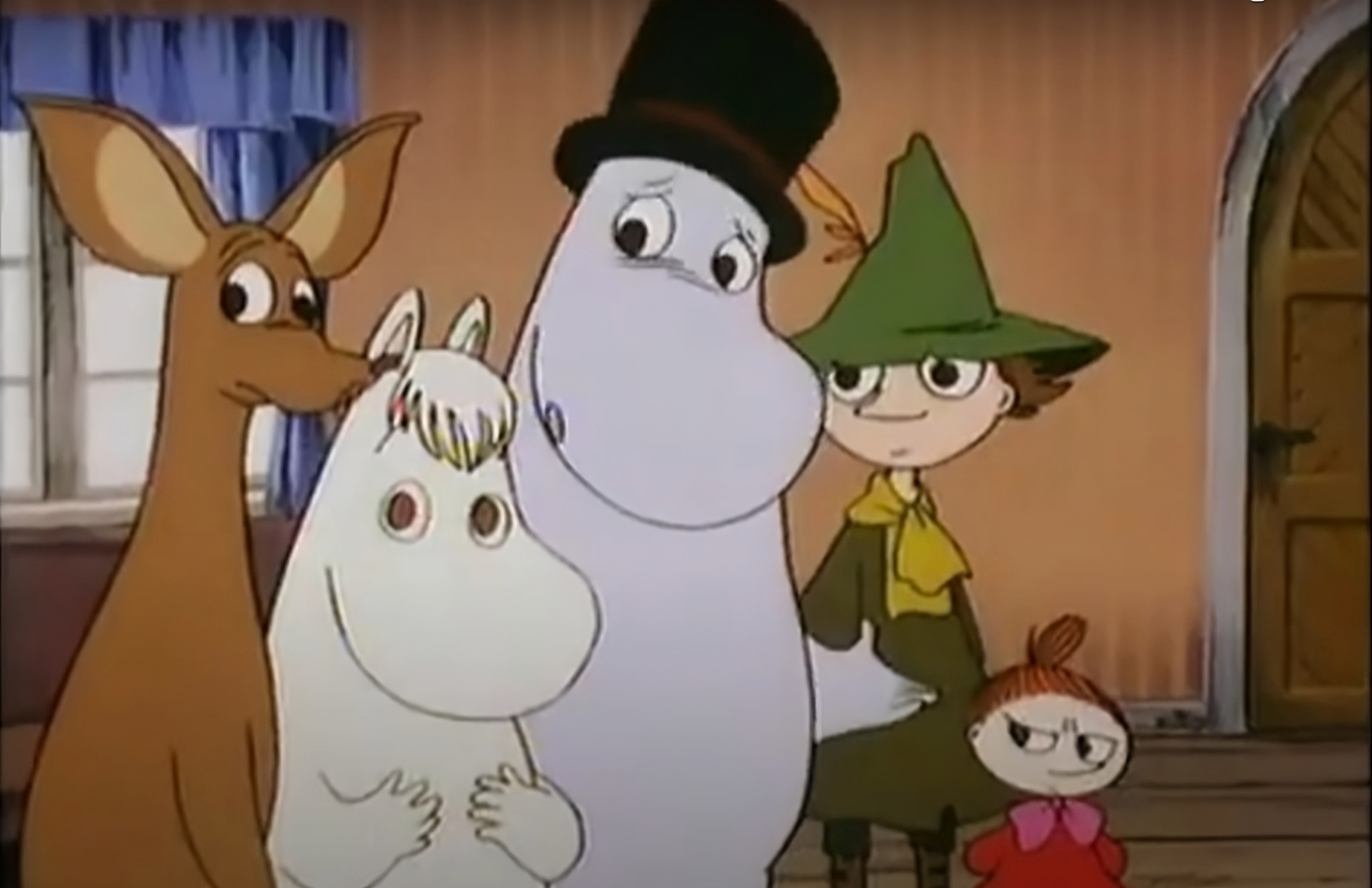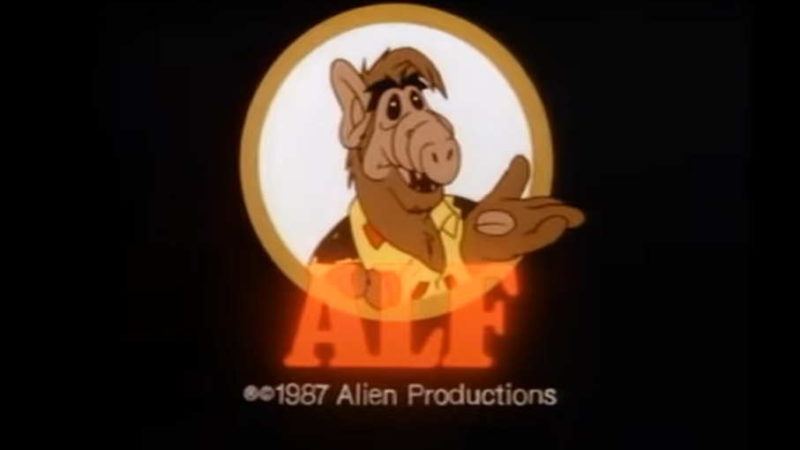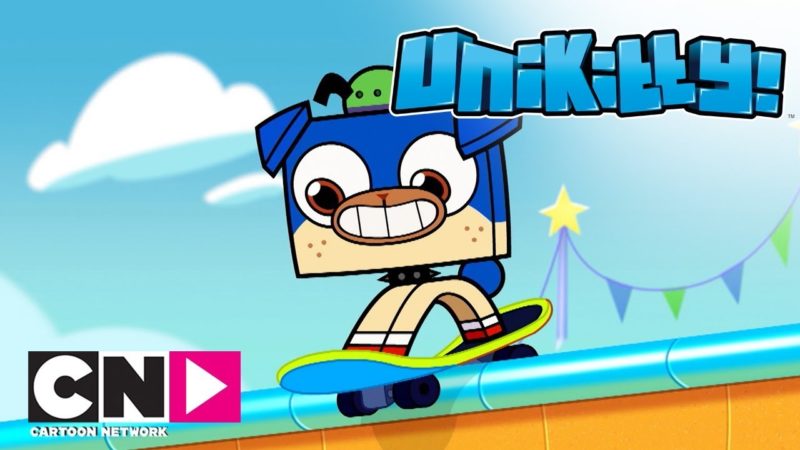Moomin – the 1990 animated series

The Moomins (Swedish: mumintrollen) have captivated generations of readers with their enchanting adventures and wacky characters. Created by Finnish writer and illustrator Tove Jansson, the Moomins have become a beloved cultural phenomenon around the world. This charming animated series and its lovable characters have won the hearts of fans of all ages, transporting them to a magical and loving world.
The first series of moominland it was broadcast by TV Tokyo from 12 April 1990, while in Italy it is unpublished. The second series was broadcast by TV Tokyo from 10 October 1991, in Italy on Italia 1 in 1994.
The Moomin family is made up of round, white characters with large faces that vaguely resemble hippopotamuses. However, despite this physical resemblance, the Moomins are actually trolls. They live in their cozy home in Moominvalley and have shared many exciting adventures with a variety of friends.
The Moomins Literary Series consists of nine books published between 1945 and 1993, along with five picture books and a comic strip. Each book is an invitation to explore the enchanted world of the Moomins, where fantasy blends with reality in a masterful way. Jansson's writing captures the imagination of readers and transports them into a universe full of adventure, mysteries and life lessons.
But the Moomins' magic didn't stop at the printed page. These beloved characters have also conquered the screen, with numerous television series and films dedicated to their adventures. Besides that, even two theme parks based on the Moomins have been created: Moomin World in Naantali, Finland, and Akebono Children's Forest Park in Hannō, Saitama, Japan. These magical places take fans on a journey into the real world of the Moomins, allowing them to fully immerse themselves in the unique and alluring atmosphere of the Moominvalley.
Over the years, Tove Jansson has shared some interesting tidbits about the creative process behind the Moomins. In a letter to Estonian linguist Paul Ariste in 1973, Jansson revealed that he had invented an artificial word, "mumintroll," which expressed something soft. According to the writer, the consonant sound "m" in particular conveyed a sensation of softness, which reflected the sweet and welcoming character of the Moomins themselves. As an artist, Jansson gave the Moomins a shape that embodied softness rather than flaccidity, thus creating a perfect balance between form and character.
The Moomins' stories revolve around a number of eccentric and wacky characters, some of whom are related to each other.
The animated series

The series helped fuel the "Moomin boom" of the 90s, including the obsession with Moomin soft toys in Japan. After the great success of the series, a sequel titled Delightful Moomin Family: Adventure Diary (楽しいムーミン一家 冒険日記, Tanoshii Mūmin Ikka: Bōken Nikki) was produced and broadcast on TV Tokyo from October 10, 1991 to March 26. 1992. The sequel series aired in several countries outside of Japan, where it was billed as another season of Moomin, although it was never dubbed into English. The original series also spawned a theatrical prequel film Comet in Moominland, based on the second novel of the same name, and video game releases.
The series has been dubbed into many languages (including, but not limited to, the aforementioned English, Swedish, Finnish, Norwegian and Danish) and broadcast worldwide. Additionally, a Northern Sami dub was made by NRK Sámi Radio and broadcast on NRK 1 in Norway and SVT1 in Sweden alongside the aforementioned Norwegian and Swedish dubs.
History



The Moomins animated series has captured the imagination of viewers since its inception when spring returns to the Moominvalley. Moomin, accompanied by Little My, Moominpappa and Moominmamma, wake up in their cozy home in Moominhouse, as Snufkin makes his return from his journey south on the very first day of spring. The first eight episodes build a gripping storyline based on the third novel in the series, “Finn Family Moomintroll”. During the story, Moomin and his friends discover a magical silk hat which is revealed to belong to the Hobgoblin. Later, the Hobgoblin takes the hat back from the Moomin family. The Moomins later find a wrecked boat, repair it, and head to a deserted island populated by Hattifatteners.
Later, two small creatures named Thingumy and Bob, with a large suitcase, arrive at the Moominhouse, followed by an ominous figure known as the Groke. After the Moomins manage to throw the Groke out of their way by giving her the Moomin shell, Thingumy and Bob are revealed to be keeping a large "King's Ruby" in their suitcase. After returning Moominmamma's lost purse, the Moomins celebrate the event with a big party, to which the Hobgoblin suddenly shows up as well. Finally, the King's Ruby problem seems to find a solution.
The Moomin series unfolds over the course of three years, allowing Moomin and his family and friends to experience two winters despite the fact that Moomin are normally supposed to go into hibernation during this season. Over the course of the series, Snork, the inventor brother, designs and builds two flying ships of different types. The first is destroyed for sabotage, while the second is completed at the end of the series. Before the second winter arrives, the Moomins and their friends also meet Alicia and her grandmother, a witch. Initially, the witch has a negative opinion of the Moomin and their kind nature, but over time she begins to recognize and appreciate their special qualities.
At the end of the series, Snork decides to go on a journey in his newly completed skyship, while Alicia and her grandmother leave Moominvalley for the third consecutive winter. The series concludes with the arrival of winter as the Moomin enter their annual hibernation and Snufkin sets off south once more.
The Moomins animated series has mesmerized audiences of all ages with its breathtaking adventures, charming characters.
Characters



Moomin, the protagonist of the animated series of the same name, has won the hearts of millions of viewers thanks to his kind spirit and great sensitivity. Like the other members of his family, Moomin is a rounded, white troll with a broad snout and glittering blue eyes. He is a loyal and selfless friend, always ready to help others. Despite his desire for adventures, Moomin is deeply attached to his family, especially Moominmamma, who understands and supports him in every situation. Among his closest friends is Wilson, with whom he shares a deep friendship.
In the Italian version of the series, Moomin is masterfully voiced by Luca Sandri, who brings the character to life with the right amount of sweetness and empathy. His talent gives Moomin a warm and engaging voice, making each adventure even more exciting for the audience.
Alongside Moomin, there are other unforgettable characters that enrich the Moominvalley universe. Moominmamma, the loving and understanding mother, is always kind to her son and to everyone she meets along the way. With her calmness and calmness of hers, she manages to handle even the most complicated situations.
Papa Moomin, interpreted by the voice of Mario Scarabelli, is the head of the family. He deeply loves his family, but is distinguished by his more severe character than Moominmamma. He is a lover of adventures and travel, and is always ready to daydream.
Hobbyhorse, known as Little My, is Wilson's vivacious half-sister. Despite her incredibly short stature and orange hair, she is full of energy and independence. She often gets carried away with aggression and teasing, but she proves to be a loyal friend to Moomin and the other members of the group.
Wilson, known as Snufkin, is Dada's half-brother. He is an enigmatic wanderer, fond of solitude but always happy to spend time with his friends, especially Moomin. His iconic green robe and hat make him instantly recognisable. Snufkin retreats from Moominland during the winter, only to return in the spring, taking his wisdom and tranquility with her.



Ruddy, also known as Snorkmaiden, is a Moomin-like troll with blonde bangs and brown eyes. She is a charming, kind and energetic character as well as being an excellent cook. Despite her vanity and impulsiveness, she proves to be loyal to her friends.
Production
Moomin is the third anime adaptation based on the novels and comics. Prior to production, author Tove Jansson was already displeased with the earlier 1969 Moomin anime adaptation due to how unfaithful the series' characters and stories were to its source material. For this reason, both the first Moomin and the 1972 New Moomin were never released or broadcast outside Japan. Since 1981, Finnish commercial and animation producer Dennis Livson started asking Tove and Lars Jansson for the rights to make another animated adaptation. Finally, Livson was able to convince both of them after seeing his previously produced animated series Alfred J Kwak and the rights for another series were obtained. A year later in Tokyo, Livson showed a small preview of the anime series for both Tove and Lars Jansson. According to Livson, Tove commented on it by saying “Dom lever ju” (“They're really alive!”).
Unlike the previous two anime adaptations, Moomin was a co-production of Dutch company Telecable Benelux BV (later renamed Telescreen from 1998 until its acquisition by media and brand management company m4e in 2008) and Japanese animation studios Telescreen Japan Inc. and Visual 80 Hiroshi Saitō and Masayuki Kojima served as lead directors on the series, while Akira Miyazaki scripted the first 12 episodes and many afterward. Tove and Lars Jansson were also involved in the script making some changes to the scripts.
In Japan, this work "Moomin" is known as "regularly broadcast even during the Gulf War". When the Gulf War (Operation Desert Storm) broke out on January 17, 1991, while other TV stations in Tokyo switched to emergency broadcasting, only TV Tokyo broadcast "Moomin" as usual and it attracted much attention.
Technical data
Author Tove Jansson
Regia Hiroshi Saito, Masayuki Kojima
Producer Kazuo Tabata, Dennis Livson
Composition series Shozo Matsuda, Akira Miyazaki
character design Yasuhiro Nakura
Music Sumio Shiratori
Studio Telecable Benelux BV, Telescreen Japan Inc., Visual 80
Network TV Tokyo
Date 1st TV April 12, 1990 - October 3, 1991
Episodes 78 (complete)
Relationship 4:3
Episode duration 24 min
Moominland, a world of serenity
Regia Takeyuki kanda
Producer Kazuo Tabata
Composition series Masaaki Sakurai
character design Yasuhiro Nakura
Music Sumio Shiratori
Studio Telecable Benelux BV
Network TV Tokyo
Date 1st TV October 10, 1991 - March 26, 1992
Episodes 26 (complete)
Relationship 4:3
Episode duration 24 min
Italian network Italia 1
Date 1st Italian TV 1994
Italian episodes 26 (complete)
Dialogues it. Pino Pirovano, Giusy Di Martino
Double studio it. Deneb Movie
Double Dir. it. Guido Rutta
Comet in Moominland
Original title Moomin Valley Comet
Mumindani no Suisei
Original language Japanese
Country of Production Japan, Finland, Norway
Year 1992
Duration 68 min
Gender animation, fantastic, adventure
Regia Hiroshi Saito
Subject Tove Jansson
Film script Akira Miyazaki
Producer Kazuo Tabata
Production house Telescreen Japan Inc., Telecable Benelux BV
Editor Seiji Morita
Music Sumio Shiratori (Japanese ed.), Pierre Kartner (International ed.)
Original voice actors
Minami Takayama: Muumin
Rei Sakuma: Mii
Ryūsei Nakao: Sniff
Takehito Koyasu: Snufkin
Akio Otsuka: Muuminpapa
Ikuko Tani as Muuminmama
Masato Yamanouchi as Jakounezumi
Mika KanaiFloren
Minoru Yada: Hemulen
Yasuyuki Hirata: Snork
Ryuzou Ishino: Skrat
Sumi Shimamoto: Viljonka
Takaya Hashi: Chief of police
Yūko Kobayashi as Mimura
Emiko Shiratori: Narrator






